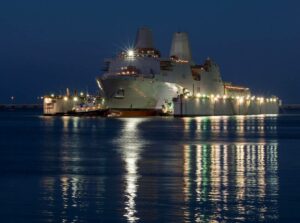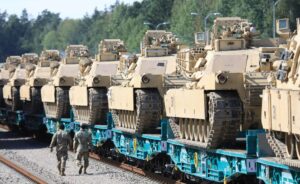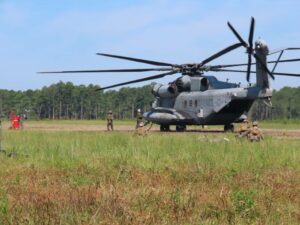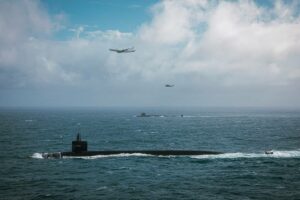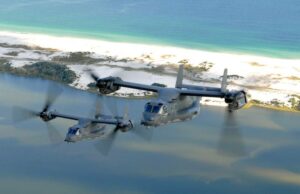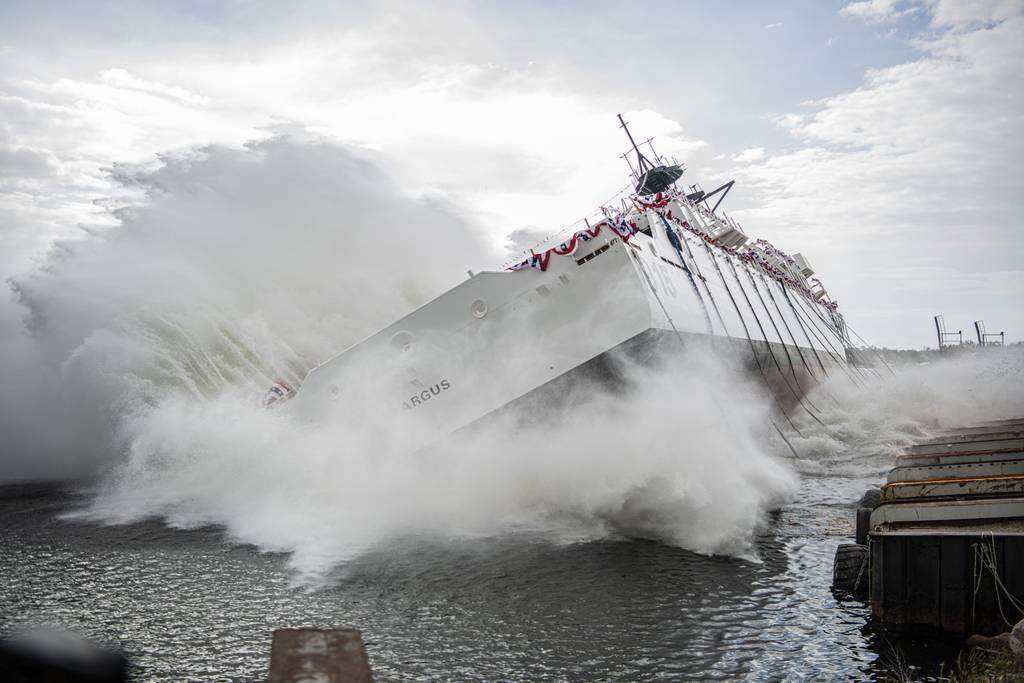
WASHINGTON — The U.S. Coast Guard, when selecting Austal USA over Eastern Shipbuilding Group to build the next 11 Offshore Patrol Cutters, highly valued Austal’s indoor steel assembly facility and lower price tag, according to recently unsealed documents from the U.S. Court of Federal Claims.
The court last month ruled against Eastern Shipbuilding, which had appealed the Coast Guard’s decision. The court unsealed the case documents Dec. 14, though with some redactions.
Among the revelations in the documents are that Eastern’s bid was judged to present less risk and included a superior design approach.
Austal was the only bidder credited with a “significant strength,” for its indoor assembly facility.
And while Eastern scored better on the five non-price factors, which were supposed to be weighted more heavily in the final decision than price, the Coast Guard determined the two “approached equality” in their scores such that Austal’s lower price tipped the scales.
Ultimately, Austal’s proposal came to $3.22 billion, or about $292 million per hull, according to the unsealed documents.
Eastern’s price is redacted in the documents but is characterized as a “very large price differential.”
Eastern Shipbuilding’s winning bid in 2016, when the OPC program was first awarded, came to about $264 million per hull — but the cost of labor and material have increased substantially since.
Though Eastern won the original 2016 deal, the Coast Guard rebid the program after the Florida yard was devastated by Hurricane Michael in 2018. The Coast Guard announced in June 2022 it selected Austal to build the next phase of 11 ships.
Eastern protested the award to the Government Accountability Office two weeks later, and in October 2022 it dropped the GAO protest to instead appeal to the U.S. Court of Federal Claims.
Eastern’s lawsuit “contends that the Coast Guard made a number of errors when it evaluated the technical merits of the proposals,” according to the court document, which addresses each claim. In each, the court either denied the merit of the claim or found the court lacked authority to go against the Coast Guard’s assessment criteria.
CLICK HERE TO VIEW THE UNSEALED COURT DOCUMENT
While Eastern argued outscoring Austal on the higher-weighted non-price factors should have resulted in a win, the court documents state the Coast Guard determined “the additional benefits that would be achieved … do not justify the price premium.”
Rather, any risk incurred from Austal’s plans “can be mitigated through special contractor emphasis and close Government monitoring.”
The court document reveals the Coast Guard was drawn to the resilience of Austal’s facilities. Specifically, it found the indoor steel assembly facility would reduce weather-related delays, particularly during welding and painting work, reduce the likelihood of corrosion and weather-related damage to the ship hulls and increase the quality of work.
The Coast Guard acknowledged Austal’s steel manufacturing line is new — the company previously built only aluminum ships at the Alabama yard — which creates some risk. It also noted only one OPC could be built in the indoor facility at a time, meaning the heel-to-toe production cadence could lend itself to “notable disruptions” to schedule.
Among Eastern’s claims is that Austal’s work on the U.S. Navy’s towing, salvage, and rescue ships and Large Unmanned Surface Vessel program using the same indoor facility “compounds Austal’s already severe schedule risk for constructing the OPC.”
The Coast Guard wrote it was comfortable managing the risk through its government oversight, and the court found it did not have the authority to second-guess that determination.
Austal USA could not be reached for comment.
Eastern Shipbuilding Group CEO Joey D’Isernia said “we are disappointed in the court’s decision.” Still, the company is interested in future opportunities to rejoin the program.
The Coast Guard plans to eventually award a Phase 3 contract for 10 additional OPCs, for a total of 25 ships. Coast Guard acquisition chief Rear Adm. Chad Jacoby said at a recent conference there’s no current plan to have both yards build concurrently into the future but that he’d be open to it if lawmakers increased annual OPC spending, since it’s “urgent” to get OPCs into the fleet to replace “the medium endurance cutters, which are struggling to maintain operational capability right now.”
In a statement to Defense News, D’Isernia said Eastern is “very interested in any path that would enable our workforce to continue building the OPCs.”
Megan Eckstein is the naval warfare reporter at Defense News. She has covered military news since 2009, with a focus on U.S. Navy and Marine Corps operations, acquisition programs and budgets. She has reported from four geographic fleets and is happiest when she’s filing stories from a ship. Megan is a University of Maryland alumna.
- SEO Powered Content & PR Distribution. Get Amplified Today.
- PlatoData.Network Vertical Generative Ai. Empower Yourself. Access Here.
- PlatoAiStream. Web3 Intelligence. Knowledge Amplified. Access Here.
- PlatoESG. Carbon, CleanTech, Energy, Environment, Solar, Waste Management. Access Here.
- PlatoHealth. Biotech and Clinical Trials Intelligence. Access Here.
- Source: https://www.defensenews.com/naval/2023/12/18/new-court-doc-sheds-light-on-austals-2022-offshore-patrol-cutter-win/
- :has
- :is
- :not
- $3
- 10
- 11
- 14
- 2016
- 2018
- 2022
- 22
- 25
- 70
- a
- About
- According
- accountability
- achieved
- acknowledged
- acquisition
- Additional
- addresses
- After
- against
- Alabama
- already
- also
- and
- annual
- any
- appeal
- approach
- ARE
- argued
- AS
- Assembly
- assessment
- At
- authority
- award
- awarded
- BE
- benefits
- Better
- bid
- Billion
- both
- Budgets
- build
- Building
- built
- but
- by
- Cadence
- came
- capability
- case
- ceo
- characterized
- chief
- claim
- claims
- Close
- Coast
- comfortable
- comment
- company
- Conference
- constructing
- continue
- contract
- Contractor
- corrosion
- Cost
- could
- Court
- covered
- creates
- criteria
- Current
- damage
- deal
- dec
- decision
- Defense
- delays
- Design
- determination
- determined
- DID
- do
- document
- documents
- drawn
- during
- each
- eastern
- either
- emphasis
- enable
- Errors
- evaluated
- eventually
- facilities
- Facility
- factors
- Federal
- Filing
- final
- First
- five
- FLEET
- florida
- Focus
- For
- found
- four
- from
- future
- GAO
- geographic
- get
- Go
- Government
- Government Accountability Office
- Group
- Guard
- had
- Have
- heavily
- here
- highly
- HTTPS
- hurricane
- if
- images
- in
- included
- Increase
- increased
- incurred
- Indoor
- instead
- interested
- into
- IT
- ITS
- itself
- Joey
- jpg
- judged
- june
- labor
- large
- Last
- later
- lawmakers
- lawsuit
- LEND
- less
- light
- likelihood
- Line
- lower
- made
- maintain
- managing
- manufacturing
- Marine
- Maryland
- material
- meaning
- medium
- Megan
- Merit
- Michael
- Military
- million
- monitoring
- Month
- more
- New
- news
- next
- no
- noted
- now
- number
- october
- of
- Office
- on
- ONE
- only
- open
- operational
- Operations
- opportunities
- or
- original
- our
- over
- Oversight
- painting
- particularly
- path
- per
- phase
- plan
- plans
- plato
- Plato Data Intelligence
- PlatoData
- Premium
- present
- previously
- price
- Production
- Program
- Programs
- proposal
- Proposals
- protest
- quality
- reached
- recent
- recently
- reduce
- replace
- Reported
- reporter
- rescue
- resilience
- resulted
- Reveals
- right
- Risk
- ruled
- s
- Said
- same
- scales
- schedule
- scored
- scores
- selected
- selecting
- severe
- she
- ship
- ships
- should
- since
- some
- special
- specifically
- Spending
- State
- Statement
- steel
- Still
- Stories
- strength
- Struggling
- substantially
- such
- superior
- supposed
- Surface
- TAG
- Technical
- than
- that
- The
- The Future
- their
- though?
- Through
- time
- to
- Total
- two
- u.s.
- U.S. Navy
- university
- University of Maryland
- USA
- using
- valued
- Vessel
- View
- was
- Weeks
- were
- when
- which
- while
- win
- winning
- with
- Won
- Work
- Workforce
- would
- wrote
- zephyrnet


